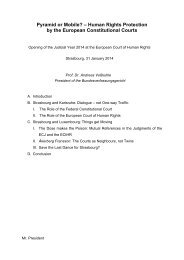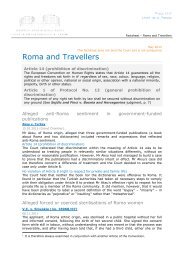The prohibition of torture - European Court of Human Rights
The prohibition of torture - European Court of Human Rights
The prohibition of torture - European Court of Human Rights
You also want an ePaper? Increase the reach of your titles
YUMPU automatically turns print PDFs into web optimized ePapers that Google loves.
1 As at 30 June 2003.<br />
Introduction to the Convention<br />
<strong>The</strong> <strong>European</strong> Convention on <strong>Human</strong> <strong>Rights</strong><br />
(hereinafter “the Convention”) was signed in Rome<br />
on 4 November 1950, and came into force on 3 May<br />
1953. Today, in 2003, 1 forty-four states have ratified<br />
the <strong>European</strong> Convention on <strong>Human</strong> <strong>Rights</strong>.<br />
In practically all these states the Convention,<br />
as well as creating legal obligations under international<br />
law, is also part <strong>of</strong> domestic law. In this way<br />
the <strong>European</strong> Convention on <strong>Human</strong> <strong>Rights</strong> is part<br />
<strong>of</strong> the legal system and it is mandatory for the<br />
domestic courts and all public authorities to apply<br />
its provisions. In national proceedings individuals<br />
may directly invoke its text and case-law, which<br />
must be applied by the national courts. Moreover,<br />
the national authorities, including the courts, must<br />
give the Convention priority over any national law<br />
conflicting with the Convention.<br />
This is in keeping with the overall scheme <strong>of</strong><br />
the Convention, which is that the initial and primary<br />
responsibility for the protection <strong>of</strong> the rights<br />
set forth in the Convention lies with the contracting<br />
states. Article 1 <strong>of</strong> the Convention obliges each<br />
contracting state to secure to everyone within their<br />
jurisdiction the rights and freedoms defined in the<br />
Convention. <strong>The</strong> <strong>European</strong> <strong>Court</strong> <strong>of</strong> <strong>Human</strong> <strong>Rights</strong><br />
is there to monitor states’ action, exercising the<br />
power <strong>of</strong> review.<br />
This relationship between the legal systems<br />
<strong>of</strong> contracting states and the <strong>Court</strong> – the subsidiarity<br />
principle – whereby the enforcement <strong>of</strong> the Convention<br />
by the national authorities goes hand in<br />
hand with <strong>European</strong> supervision, has given rise to<br />
the existence <strong>of</strong> a so-called “margin <strong>of</strong> appreciation”.<br />
<strong>The</strong> doctrine <strong>of</strong> the margin <strong>of</strong> appreciation<br />
recognises that in many instances national authorities<br />
are in a better position to decide on a particular<br />
case or issue. This is particularly true where<br />
there is a wide range <strong>of</strong> options as to how a matter<br />
can be resolved. However, the margin <strong>of</strong> appreciation<br />
is applied differently depending on the value<br />
at stake, and the existence <strong>of</strong> common standards<br />
applied across many member states, and accordingly<br />
the degree <strong>of</strong> discretion allowed to the states<br />
varies.<br />
5
















